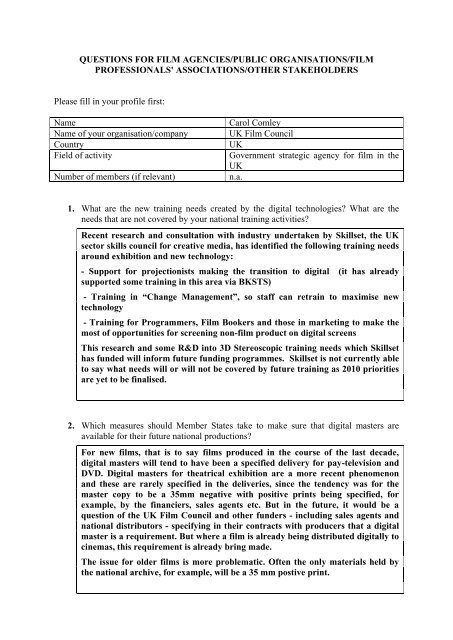Views on the opportunities and challenges for digital cinema - BFI
Views on the opportunities and challenges for digital cinema - BFI
Views on the opportunities and challenges for digital cinema - BFI
You also want an ePaper? Increase the reach of your titles
YUMPU automatically turns print PDFs into web optimized ePapers that Google loves.
QUESTIONS FOR FILM AGENCIES/PUBLIC ORGANISATIONS/FILM<br />
PROFESSIONALS' ASSOCIATIONS/OTHER STAKEHOLDERS<br />
Please fill in your profile first:<br />
Name Carol Comley<br />
Name of your organisati<strong>on</strong>/company UK Film Council<br />
Country UK<br />
Field of activity Government strategic agency <strong>for</strong> film in <strong>the</strong><br />
UK<br />
Number of members (if relevant) n.a.<br />
1. What are <strong>the</strong> new training needs created by <strong>the</strong> <strong>digital</strong> technologies? What are <strong>the</strong><br />
needs that are not covered by your nati<strong>on</strong>al training activities?<br />
Recent research <strong>and</strong> c<strong>on</strong>sultati<strong>on</strong> with industry undertaken by Skillset, <strong>the</strong> UK<br />
sector skills council <strong>for</strong> creative media, has identified <strong>the</strong> following training needs<br />
around exhibiti<strong>on</strong> <strong>and</strong> new technology:<br />
- Support <strong>for</strong> projecti<strong>on</strong>ists making <strong>the</strong> transiti<strong>on</strong> to <strong>digital</strong> (it has already<br />
supported some training in this area via BKSTS)<br />
- Training in “Change Management”, so staff can retrain to maximise new<br />
technology<br />
- Training <strong>for</strong> Programmers, Film Bookers <strong>and</strong> those in marketing to make <strong>the</strong><br />
most of <strong>opportunities</strong> <strong>for</strong> screening n<strong>on</strong>-film product <strong>on</strong> <strong>digital</strong> screens<br />
This research <strong>and</strong> some R&D into 3D Stereoscopic training needs which Skillset<br />
has funded will in<strong>for</strong>m future funding programmes. Skillset is not currently able<br />
to say what needs will or will not be covered by future training as 2010 priorities<br />
are yet to be finalised.<br />
2. Which measures should Member States take to make sure that <strong>digital</strong> masters are<br />
available <strong>for</strong> <strong>the</strong>ir future nati<strong>on</strong>al producti<strong>on</strong>s?<br />
For new films, that is to say films produced in <strong>the</strong> course of <strong>the</strong> last decade,<br />
<strong>digital</strong> masters will tend to have been a specified delivery <strong>for</strong> pay-televisi<strong>on</strong> <strong>and</strong><br />
DVD. Digital masters <strong>for</strong> <strong>the</strong>atrical exhibiti<strong>on</strong> are a more recent phenomen<strong>on</strong><br />
<strong>and</strong> <strong>the</strong>se are rarely specified in <strong>the</strong> deliveries, since <strong>the</strong> tendency was <strong>for</strong> <strong>the</strong><br />
master copy to be a 35mm negative with positive prints being specified, <strong>for</strong><br />
example, by <strong>the</strong> financiers, sales agents etc. But in <strong>the</strong> future, it would be a<br />
questi<strong>on</strong> of <strong>the</strong> UK Film Council <strong>and</strong> o<strong>the</strong>r funders - including sales agents <strong>and</strong><br />
nati<strong>on</strong>al distributors - specifying in <strong>the</strong>ir c<strong>on</strong>tracts with producers that a <strong>digital</strong><br />
master is a requirement. But where a film is already being distributed <strong>digital</strong>ly to<br />
<strong>cinema</strong>s, this requirement is already bring made.<br />
The issue <strong>for</strong> older films is more problematic. Often <strong>the</strong> <strong>on</strong>ly materials held by<br />
<strong>the</strong> nati<strong>on</strong>al archive, <strong>for</strong> example, will be a 35 mm postive print.
3. Who should pay <strong>for</strong> <strong>the</strong> producti<strong>on</strong> costs of a <strong>digital</strong> master (DSM)?<br />
For new producti<strong>on</strong>s, <strong>the</strong> cost should be an integral part of <strong>the</strong> budget. However<br />
<strong>the</strong>re might be specific requirements by <strong>the</strong> licensee - <strong>for</strong> example to produce <strong>the</strong><br />
Blueray disk - <strong>and</strong> will be subject to <strong>the</strong> c<strong>on</strong>tract between <strong>the</strong> producer <strong>and</strong> <strong>the</strong><br />
distributor.<br />
For older films - as is dem<strong>on</strong>strated by <strong>the</strong> experience of Eurimages whose offer<br />
to producers to finance in whole or in part <strong>the</strong> producti<strong>on</strong> of DSMs <strong>for</strong> films in<br />
which Eurimages had participated was ignored by producers - <strong>the</strong> issue is more<br />
complicated.<br />
Funding bodies in <strong>the</strong> member states, al<strong>on</strong>g with nati<strong>on</strong>al archives <strong>and</strong> <strong>the</strong><br />
European Commissi<strong>on</strong>, should work to ensure that all feature films are available<br />
in a <strong>digital</strong> <strong>for</strong>mat of a high enough st<strong>and</strong>ard to permit <strong>the</strong> producti<strong>on</strong> of <strong>digital</strong><br />
copies <strong>for</strong> high-definiti<strong>on</strong> plat<strong>for</strong>ms (including <strong>the</strong>atrical). It should be kept in<br />
mind that some films will not obtain a <strong>the</strong>atrical release. In such cases, it would<br />
be inappropriate to <strong>for</strong>ce filmmakers to go to <strong>the</strong> expense of creating a <strong>digital</strong><br />
master <strong>for</strong> <strong>the</strong>atrical exhibiti<strong>on</strong> which will never be used.<br />
The usual positi<strong>on</strong> is that <strong>the</strong> costs of producing a master of <strong>the</strong> film (whe<strong>the</strong>r<br />
35mm or <strong>digital</strong>) is borne from <strong>the</strong> producti<strong>on</strong> budget. The master has to be<br />
adapted to create new 'masters' <strong>for</strong> each distributi<strong>on</strong> <strong>for</strong>mat because <strong>the</strong> frame<br />
per sec<strong>on</strong>d speed is different, <strong>for</strong> example, between <strong>cinema</strong> projecti<strong>on</strong> <strong>and</strong> DVD.<br />
Such costs have tended to be borne by <strong>the</strong> nati<strong>on</strong>al distributor.<br />
4. How can <strong>the</strong> "pay <strong>on</strong>ce approach" be encouraged (= <strong>on</strong>e single master, to be slightly<br />
adapted <strong>for</strong> each distributi<strong>on</strong> channel: <strong>cinema</strong>, HDTV, DVD…)?<br />
As noted by our colleagues in Francoph<strong>on</strong>e Belgium, we do not assume that <strong>the</strong><br />
approach of "slightly adapting" a single master <strong>for</strong> each distributi<strong>on</strong> channel is<br />
necessarily an opti<strong>on</strong>: <strong>the</strong> differences between a copy of a film intended <strong>for</strong><br />
<strong>the</strong>atrical release <strong>and</strong> <strong>on</strong>e <strong>for</strong> release, <strong>for</strong> example, <strong>on</strong> <strong>digital</strong> terrestrial televisi<strong>on</strong>,<br />
may be significant - not <strong>on</strong>ly with regard to <strong>the</strong> image but also to <strong>the</strong> sound. A<br />
"pay <strong>on</strong>ce approach" might result in a versi<strong>on</strong> of a film which is a compromise<br />
between <strong>the</strong> dem<strong>and</strong>s of <strong>the</strong> different plat<strong>for</strong>ms <strong>and</strong> this may be sub-optimal. As<br />
a general principle, we would suggest that this is an issue best left to <strong>the</strong> market.<br />
5. How can <strong>the</strong> inter-operability of <strong>the</strong> different projecti<strong>on</strong> systems be ensured?<br />
If by "inter-operability" it is intended that any copy of any film should be able to<br />
play <strong>on</strong> any projecti<strong>on</strong> system, this presumably could be ensured by sophisticated<br />
decoders <strong>and</strong> machines capable of taking everything from a digibeta tape to a<br />
Blueray disk to a 70mm print, but this might be so dem<strong>and</strong>ing that it would not<br />
be worthwhile.<br />
As far as projecti<strong>on</strong> of <strong>digital</strong> prints in <strong>the</strong>atres is c<strong>on</strong>cerned, different integrators<br />
could be obliged to ensure that every film can play out from every server <strong>and</strong><br />
through every projector, but this is unrealistic. We assume that as <strong>digital</strong>
projecti<strong>on</strong> becomes more widespread, de-facto st<strong>and</strong>ards will be established <strong>and</strong><br />
<strong>the</strong> ability to play out a <strong>digital</strong> copy <strong>on</strong> systems o<strong>the</strong>r than that <strong>for</strong> which it was<br />
originally intended will improve. As <strong>for</strong> questi<strong>on</strong> 4, we would suggest that this is<br />
an issue best left to <strong>the</strong> market.<br />
As l<strong>on</strong>g as all DCI-certified <strong>digital</strong> <strong>cinema</strong> equipment can play <strong>the</strong> same <strong>for</strong>mat,<br />
i.e. single inventory product, <strong>the</strong>n this might be termed interoperability. This<br />
mirrors <strong>the</strong> 35mm world. One might argue that today's DC equipment should be<br />
able to play o<strong>the</strong>r <strong>for</strong>mats e.g. Bluray, digibeta etc. but this is ano<strong>the</strong>r argument:<br />
it is a commercial decisi<strong>on</strong> that goes bey<strong>on</strong>d <strong>the</strong> principle that a DCI copy should<br />
be able to play out <strong>on</strong> any DCI equipment, irrespective of manufacturer <strong>and</strong><br />
equipment c<strong>on</strong>figurati<strong>on</strong>.<br />
6. Should <strong>the</strong>re be <strong>on</strong>e single st<strong>and</strong>ard <strong>for</strong> <strong>digital</strong> projecti<strong>on</strong>?<br />
As indicated in <strong>the</strong> answer to questi<strong>on</strong> 5, we believe that de facto st<strong>and</strong>ards will<br />
energe; we would note, based <strong>on</strong> <strong>the</strong> comments of our colleagues in Rome from<br />
SMPTE <strong>and</strong> <strong>the</strong> EDCF, that this single st<strong>and</strong>ard does not yet exist although we<br />
are in<strong>for</strong>med that this situati<strong>on</strong> will be resolved in <strong>the</strong> very near future. We are<br />
doubtful whe<strong>the</strong>r a single obligatory st<strong>and</strong>ard is possible or desirable: it may well<br />
be that a film will be made in a given community to be showed in a given <strong>cinema</strong><br />
<strong>and</strong>, as desrable as it might be that this film could be shown elsewhere, this might<br />
well involve some kind of st<strong>and</strong>ards c<strong>on</strong>versi<strong>on</strong>. One might imagine a film made<br />
in Kerela <strong>for</strong> showing in Kerela being taken up <strong>for</strong> distributi<strong>on</strong> in <strong>the</strong> UK <strong>and</strong> <strong>the</strong><br />
properties of such a film might well involve some adaptati<strong>on</strong> (as, <strong>for</strong> example,<br />
<strong>the</strong>y do with regard to language or subtitling). Again, we would suggest that this<br />
is an issue best left to <strong>the</strong> market<br />
That said, <strong>the</strong> UK Film Council supports <strong>the</strong> c<strong>on</strong>cept of a single st<strong>and</strong>ard.<br />
Whatever happens in <strong>the</strong> <strong>digital</strong> world should at least mirror what happens in <strong>the</strong><br />
35mm world i.e. a 35mm print will play <strong>on</strong> any 35 mm projector anywhere in <strong>the</strong><br />
world. (It is worth remembering that a similar discussi<strong>on</strong> took place at <strong>the</strong><br />
beginning of <strong>cinema</strong> with regard to sprocket shapes etc.) Likewise, in <strong>the</strong> <strong>digital</strong><br />
world, a <strong>digital</strong> projector should be able to play any <strong>digital</strong> copy that was<br />
prepared <strong>for</strong> it. The DCI st<strong>and</strong>ard currently covers both of <strong>the</strong>se elements <strong>and</strong><br />
has become <strong>the</strong> de facto st<strong>and</strong>ard. It way well be <strong>the</strong> case that certain producers<br />
will accept a lower st<strong>and</strong>ard <strong>for</strong> <strong>the</strong>ir product <strong>and</strong> <strong>the</strong>re may be certain <strong>cinema</strong>s<br />
with lower st<strong>and</strong>ard equipment ready to play it. That is <strong>the</strong>ir own commercial<br />
decisi<strong>on</strong>. However, it is not reas<strong>on</strong>able <strong>for</strong> producti<strong>on</strong> <strong>and</strong> distributi<strong>on</strong> to have<br />
various inventories of product available to play <strong>on</strong> different st<strong>and</strong>ards of play-out<br />
equipment. Again, pragmatically, such exhibitors should not expect o<strong>the</strong>r<br />
producers <strong>and</strong> distributors to accept <strong>the</strong>ir lower st<strong>and</strong>ard <strong>and</strong> <strong>the</strong>ir business<br />
plans should be written to exclude <strong>the</strong> possibility of playing much of <strong>the</strong> major<br />
product from around <strong>the</strong> world. If <strong>the</strong>y are happy with this, <strong>the</strong>n so be it.<br />
It might also be argued that in <strong>the</strong> 35mm world, both large <strong>and</strong> small producers<br />
can have <strong>the</strong>ir product exhibited to <strong>the</strong> same st<strong>and</strong>ard worldwide. Why <strong>the</strong>n<br />
should a system that allows certain product to be played at a lower st<strong>and</strong>ard be<br />
encouraged?
7. Should <strong>the</strong>re be a pan-European database <strong>for</strong> trusted device lists (equipment<br />
certificates)?<br />
This might well be an asset <strong>for</strong> both suppliers <strong>and</strong> users of equipment but we<br />
would be wary of such a database becoming a barrier to entry <strong>for</strong> innovative<br />
firms as happened in <strong>the</strong> case of network terminal equipment in <strong>the</strong> telecoms<br />
world.<br />
8. How could <strong>the</strong> regi<strong>on</strong>s/municipalities c<strong>on</strong>tribute to <strong>the</strong> <strong>digital</strong> equipment of <strong>the</strong>ir local<br />
<strong>cinema</strong>s?<br />
We see regi<strong>on</strong>s <strong>and</strong> municipalities having a vital role to play in <strong>the</strong> digitisati<strong>on</strong> of<br />
<strong>the</strong>ir local <strong>cinema</strong>s, as <strong>the</strong>y do in all aspects of infrastructure <strong>and</strong> social<br />
provisi<strong>on</strong>. In order <strong>for</strong> regi<strong>on</strong>s <strong>and</strong> municipalities to c<strong>on</strong>tribute more, <strong>the</strong><br />
Commissi<strong>on</strong> <strong>and</strong> member states should work toge<strong>the</strong>r with industry to raise <strong>the</strong><br />
awareness of regi<strong>on</strong>s <strong>and</strong> municipalities of <strong>the</strong> <strong>challenges</strong> represented by<br />
digitisati<strong>on</strong> <strong>and</strong> <strong>the</strong> soluti<strong>on</strong>s available, including co-operating to acquire<br />
equipment <strong>for</strong> many <strong>cinema</strong>s <strong>and</strong> arranging <strong>for</strong> <strong>the</strong> installati<strong>on</strong> <strong>and</strong> maintenance<br />
of that equipment, as well as <strong>the</strong> training <strong>and</strong> c<strong>on</strong>sciousness-raising of operators.<br />
We would note that an area which has been neglected in both public policy <strong>and</strong><br />
commercial strategy is <strong>the</strong> development of sufficient managers of venues<br />
programming films who are capable of seizing <strong>the</strong> <strong>opportunities</strong> presented by<br />
digitial <strong>for</strong> showing a broader range of films <strong>and</strong> alternative c<strong>on</strong>tent, greater<br />
programming flexibility, reaching out to parts of <strong>the</strong> society that have<br />
traditi<strong>on</strong>ally not been well-served by <strong>cinema</strong>, <strong>and</strong> <strong>the</strong> need <strong>for</strong> more educati<strong>on</strong>,<br />
audience development <strong>and</strong> audience engagement, as well as new <strong>for</strong>ms of<br />
marketing <strong>and</strong> community-building.<br />
9. Which role could <strong>the</strong> European Structural Funds (ESF) play? (How) should <strong>the</strong><br />
Member States be encouraged to use <strong>the</strong> ESF <strong>for</strong> <strong>the</strong> digitisati<strong>on</strong> of <strong>the</strong>ir <strong>cinema</strong>s?<br />
The ESF has already played a role in digitisati<strong>on</strong> <strong>and</strong> could be more involved, <strong>for</strong><br />
example by fur<strong>the</strong>r promoting best practice <strong>on</strong> <strong>the</strong> part of member states to<br />
secure access <strong>and</strong> regi<strong>on</strong>al funding <strong>for</strong> digitisati<strong>on</strong>. This could be d<strong>on</strong>e, <strong>for</strong><br />
example, by <strong>the</strong> Commissi<strong>on</strong> encouraging member states <strong>and</strong> regi<strong>on</strong>s to<br />
<strong>for</strong>mulate <strong>the</strong>ir strategies <strong>for</strong> digitisati<strong>on</strong> <strong>and</strong> to discuss those strategies with <strong>the</strong><br />
Commissi<strong>on</strong> as already happens in o<strong>the</strong>r areas, <strong>for</strong> example (we assume)<br />
reducing <strong>the</strong> carb<strong>on</strong> footprint, improving phyto-sanitary arrangements, waste<br />
disposal, water management etc.<br />
10. To which extent/Under which c<strong>on</strong>diti<strong>on</strong>s should <strong>the</strong> Member States financially<br />
support <strong>the</strong> digitisati<strong>on</strong> of <strong>the</strong>ir <strong>cinema</strong>s?<br />
The UK Film Council has been working with o<strong>the</strong>r film agencies in Europe,<br />
notably through <strong>the</strong> European Film Agency Directors' (EFADs) network <strong>and</strong> in<br />
discussi<strong>on</strong> with DG Competiti<strong>on</strong>, precisely to agree <strong>the</strong> terms <strong>for</strong> public m<strong>on</strong>ey
eing used to facilitate digitisati<strong>on</strong> of <strong>cinema</strong>s. The c<strong>on</strong>sensus at which <strong>the</strong><br />
EFADs has arrived was set out in <strong>the</strong> San Sebastian Declarati<strong>on</strong> which was<br />
published in September 2009. This was fur<strong>the</strong>r discussed when <strong>the</strong> EFADs met<br />
with <strong>the</strong> Commissi<strong>on</strong> <strong>on</strong> 16 December 2009. This topic has still not been<br />
exhausted: apart from underst<strong>and</strong>ing better <strong>the</strong> needs of <strong>the</strong> exhibiti<strong>on</strong> sector,<br />
<strong>the</strong> EFADs are waiting to find out what, in additi<strong>on</strong> to <strong>the</strong> €4 milli<strong>on</strong>-a-year<br />
proposed by <strong>the</strong> MEDIA Programme, <strong>the</strong> Commissi<strong>on</strong> is proposing to help make<br />
available through <strong>the</strong> ESF, EIB <strong>and</strong> <strong>the</strong> EIF, not to menti<strong>on</strong> <strong>the</strong> CIP <strong>and</strong> o<strong>the</strong>r<br />
funds available <strong>for</strong> innovati<strong>on</strong>. We assume that, as part of its m<strong>and</strong>ate, <strong>the</strong> new<br />
DG Digital will address this questi<strong>on</strong>. But, in general terms, <strong>the</strong> UK Film Council<br />
agrees with <strong>the</strong> propositi<strong>on</strong> made by <strong>the</strong> Commissi<strong>on</strong>, <strong>for</strong> example in <strong>the</strong><br />
background paper which accompanies this c<strong>on</strong>sultati<strong>on</strong>, that a significant<br />
number (around two-thirds) of screens will be able to make <strong>the</strong> transiti<strong>on</strong> to<br />
<strong>digital</strong> without any public support. The o<strong>the</strong>r <strong>on</strong>e-third may well require some<br />
public support or else will be unable to make <strong>the</strong> transiti<strong>on</strong>, certainly not in <strong>the</strong><br />
short timeframe which <strong>the</strong> Commissi<strong>on</strong> <strong>and</strong> many member states favour. The<br />
<strong>cinema</strong>s in this porti<strong>on</strong> - accounting <strong>for</strong> about 10,000 screens - tend to be m<strong>on</strong>oscreen<br />
<strong>cinema</strong>s in disadvantaged or less advantaged parts of Europe; it may well<br />
be that a porti<strong>on</strong> of <strong>the</strong>se <strong>cinema</strong>s require support in order to be refurbished<br />
(seats, building structure) <strong>and</strong> may, at <strong>the</strong> end of <strong>the</strong> day, be in <strong>the</strong> wr<strong>on</strong>g place,<br />
<strong>for</strong> example, in a community that has seen industries close <strong>and</strong> populati<strong>on</strong> move<br />
out so that <strong>the</strong> community as a whole is no l<strong>on</strong>ger viable. In <strong>the</strong>se extreme cases,<br />
public authorities may be intervening to revitalise <strong>the</strong> community, <strong>and</strong><br />
maintaining or creating <strong>cinema</strong>s may be part of <strong>the</strong> public strategy.<br />
11. How can <strong>the</strong> complementarity of public support schemes with <strong>the</strong> existing VPF<br />
models be ensured?<br />
As <strong>the</strong> CNC has argued, it is vital that <strong>the</strong> digitising of <strong>cinema</strong>s is not allowed to<br />
determine how those <strong>cinema</strong>s are programmed: how l<strong>on</strong>g <strong>the</strong>y play a film,<br />
whe<strong>the</strong>r a screen is used exclusively <strong>for</strong> <strong>on</strong>e title <strong>for</strong> a pre-defined period,<br />
whe<strong>the</strong>r different films are treated differently by <strong>the</strong> exhibitor <strong>on</strong>ly because of<br />
<strong>the</strong> identity of <strong>the</strong> distributor (i.e. <strong>the</strong> terms of <strong>the</strong> VPF are such that <strong>the</strong><br />
exhibitor is discouraged from showing films from o<strong>the</strong>r distributors). There<strong>for</strong>e<br />
<strong>on</strong>e aspect of <strong>the</strong> complementarity is that public support schemes serve to lessen<br />
<strong>the</strong> restricti<strong>on</strong>s imposed by a distributor <strong>on</strong> an exhibitor.<br />
Ano<strong>the</strong>r aspect of such complementarity is that if, <strong>for</strong> any reas<strong>on</strong>, an exhibitor<br />
cannot agree a VPF deal (<strong>for</strong> example because he or she wants to programme<br />
more older films or screen <strong>the</strong>m fewer times, or perhaps show films from<br />
distributors which do not have <strong>the</strong> means to pay a VPF, or perhaps even because<br />
<strong>the</strong> exhibitor's strategy is to show alternative c<strong>on</strong>tent including films from <strong>the</strong><br />
local community, <strong>the</strong>n <strong>the</strong> exhibitor should have available alternative ways of<br />
financing <strong>the</strong> costs of digitising. This could be 'pure' subsidy (including a public<br />
body c<strong>on</strong>tributing to <strong>the</strong> cost of equipment, as <strong>the</strong> UK Film Council did with <strong>the</strong><br />
members of <strong>the</strong> UK's Digital Screen Network) or it could be providing<br />
guarantees in order to assist <strong>the</strong> exhibitor to lease equipment or to borrow m<strong>on</strong>ey<br />
from a bank.<br />
Usually VPF deals last 8-10 years. The VPF payable should cover off<br />
approximately 75/80% of <strong>the</strong> total equipment cost with <strong>the</strong> exhibitor funding <strong>the</strong>
est from its own resources. Distributors thus are diverting certain sums from<br />
<strong>the</strong>ir print budget to help support <strong>the</strong> <strong>digital</strong> roll-out. This is a mechanism that<br />
works well <strong>for</strong> many <strong>cinema</strong>s, predominantly those that always play majors'<br />
product <strong>on</strong> <strong>the</strong> general release date <strong>and</strong> would normally receive a br<strong>and</strong> new<br />
35mm copy.<br />
However, <strong>the</strong> mechanism works less well, if at all, <strong>for</strong> those <strong>cinema</strong>s which<br />
generally open a film at some subsequent point in <strong>the</strong> release cycle <strong>and</strong> would, in<br />
<strong>the</strong> 35mm world, receive a print from ano<strong>the</strong>r <strong>cinema</strong>. For <strong>the</strong>se types of <strong>cinema</strong>s<br />
- <strong>and</strong> generally <strong>the</strong>y are smaller, independently-owned, sometimes part-time - it is<br />
unlikely that <strong>the</strong>y will receive a VPF that makes any significant c<strong>on</strong>tributi<strong>on</strong> to<br />
<strong>the</strong> overall equipment cost since <strong>the</strong> cost of shipping a used print is relatively<br />
small. This is <strong>the</strong> paradox with <strong>the</strong> whole VPF mechanism: those that need it least<br />
get most, <strong>and</strong> those that need it most get least.<br />
It is clear from discussi<strong>on</strong>s with distributi<strong>on</strong> that <strong>the</strong> m<strong>on</strong>ey <strong>the</strong>y are willing to<br />
devote to <strong>the</strong> exhibiti<strong>on</strong> sector via <strong>the</strong> VPF is no more than <strong>the</strong>y would spend <strong>on</strong><br />
35mm anyway. In o<strong>the</strong>r words, <strong>the</strong>y are not devoting any extra funds to <strong>the</strong><br />
project. This is arguably an unequal approach <strong>and</strong> <strong>on</strong>e might make <strong>the</strong> point that<br />
<strong>the</strong> technology change is a requirement being pushed ra<strong>the</strong>r than pulled. Major<br />
distributors, thus, might be be under an obligati<strong>on</strong> to ensure that ALL <strong>cinema</strong>s<br />
receive equal treatment.<br />
12. To which extent should distributors c<strong>on</strong>tribute to <strong>the</strong> costs of <strong>digital</strong> equipment?<br />
Distributors <strong>and</strong> exhibitors are each o<strong>the</strong>r's customers; <strong>the</strong>y each have o<strong>the</strong>r sets<br />
of customers (producers <strong>on</strong> <strong>the</strong> <strong>on</strong>e h<strong>and</strong>, <strong>the</strong> public <strong>on</strong> <strong>the</strong> o<strong>the</strong>r); <strong>the</strong>y also have<br />
o<strong>the</strong>r suppliers: in <strong>the</strong> case of <strong>the</strong> distributors <strong>the</strong>se suppliers include film labs<br />
<strong>and</strong> shipping companies; in <strong>the</strong> case of exhibitors <strong>the</strong>se suppliers include <strong>the</strong><br />
makers of popcorn, carrot cake, espresso machines <strong>and</strong> beer pumps. Do <strong>the</strong><br />
distributors <strong>and</strong> exhibitors seek each o<strong>the</strong>r's help in relati<strong>on</strong> to <strong>the</strong>se o<strong>the</strong>r<br />
suppliers? As a general propositi<strong>on</strong>, <strong>the</strong> distributor should charge <strong>the</strong> exhibitor<br />
m<strong>on</strong>ey <strong>for</strong> <strong>the</strong> goods <strong>and</strong> services he or she supplies to <strong>the</strong> exhibitor <strong>and</strong> vice<br />
versa. A VPF deal is really <strong>on</strong>ly a guarantee <strong>for</strong> <strong>the</strong> exhibitor of <strong>the</strong> m<strong>on</strong>ey<br />
required to cover <strong>the</strong> leasing or purchasing of <strong>the</strong> equipment. It is also a<br />
commitment by <strong>the</strong> distributor to supply films to <strong>the</strong> exhibitor. The problem with<br />
<strong>the</strong> commitment by <strong>the</strong> distributor is that this can easily become a block-booking<br />
or film-bundling arrangement which many member states have made illegal<br />
under competiti<strong>on</strong> law. So it would be far better if <strong>the</strong> distributor was not liable<br />
<strong>for</strong> <strong>the</strong> cost of digitising <strong>the</strong> <strong>cinema</strong>, but ra<strong>the</strong>r that <strong>the</strong> terms entered into<br />
between <strong>the</strong> distributor <strong>and</strong> <strong>the</strong> exhibitor reflected <strong>the</strong> new c<strong>on</strong>diti<strong>on</strong>s in which<br />
costs are being borne <strong>and</strong> benefits being enjoyed. So a VPF deal which enables<br />
<strong>the</strong> distributor to share with <strong>the</strong> exhibitor <strong>the</strong> savings achieved through<br />
digitisati<strong>on</strong>, <strong>and</strong> which <strong>the</strong> exhibitor can apply to <strong>the</strong> obtaining of new<br />
equipment, is very efficient. A VPF deal which involves a precommitment by an<br />
exhibitor to screen films as yet unseen <strong>for</strong> a pre-defined period, is inefficient. But<br />
a deal which compels a distributor to pass over to <strong>the</strong> exhibitor revenues related<br />
to tickets that have not been sold is also inefficient. Of course, this problem is<br />
academic in <strong>the</strong> case of firms that are both suppliers of films <strong>and</strong> suppliers of<br />
screens (such as Medusa or Nordisk, Pathé or Lusomundo) but, since, in practice,<br />
<strong>the</strong>re are no <strong>cinema</strong>s that are completely tied to <strong>on</strong>e distributor (with <strong>the</strong> possible
excepti<strong>on</strong> of Imax <strong>cinema</strong>s), <strong>and</strong> no distributors which <strong>on</strong>ly supply <strong>the</strong>ir own<br />
<strong>cinema</strong>s, this issue does have to be c<strong>on</strong>fr<strong>on</strong>ted. And <strong>the</strong> answer to <strong>the</strong> questi<strong>on</strong> is:<br />
insofar as distributors are in a positi<strong>on</strong> to c<strong>on</strong>tribute to <strong>the</strong> costs <strong>on</strong> terms which<br />
are not distortive or discriminatory.<br />
13. To which extent would a scheme facilitating <strong>the</strong> access of exhibitors to credit or<br />
supporting <strong>the</strong>ir financing costs be relevant?<br />
For a significant number of exhibitors, it would be highly relevant.<br />
14. How can <strong>the</strong> complementarity of a possible EU scheme with nati<strong>on</strong>al/regi<strong>on</strong>al support<br />
schemes be ensured?<br />
Annexes<br />
This issue is broached in <strong>the</strong> answer to questi<strong>on</strong> 10. It is necessary <strong>for</strong> member<br />
states <strong>and</strong> regi<strong>on</strong>s, in discussi<strong>on</strong> with <strong>and</strong> <strong>the</strong> help of <strong>the</strong> Commissi<strong>on</strong>, <strong>on</strong> <strong>the</strong> <strong>on</strong>e<br />
h<strong>and</strong>, <strong>and</strong> industry <strong>and</strong> o<strong>the</strong>r stakeholders (e.g. banks <strong>and</strong> private investors) <strong>on</strong><br />
<strong>the</strong> o<strong>the</strong>r, to come up with optimum arrangements <strong>for</strong> digitisati<strong>on</strong>. It is also<br />
necessary <strong>for</strong> <strong>the</strong> Commissi<strong>on</strong> to come up with an approach to which <strong>the</strong> various<br />
DGs which have a stake in this matter, presumably led by DG Digital, c<strong>on</strong>tribute.<br />
Only in this way can complementarity be achieved.<br />
If you wish to include documents in additi<strong>on</strong> to <strong>the</strong> questi<strong>on</strong>s you have answered in <strong>the</strong> <strong>for</strong>m,<br />
please include <strong>the</strong>m as attachments in your e-mail reply.<br />
Please remember to note <strong>the</strong> questi<strong>on</strong> number corresp<strong>on</strong>ding to <strong>the</strong> document you include.<br />
Please save <strong>and</strong> send this <strong>for</strong>m to<br />
INFSO-CONSDIGICINEMA-AGENCIES@ec.europa.eu<br />
ANNEX: O<strong>the</strong>r issues caused in <strong>the</strong> document produced by <strong>the</strong> Commissi<strong>on</strong> <strong>on</strong><br />
<strong>opportunities</strong> <strong>and</strong> <strong>challenges</strong> <strong>for</strong> European Cinema in <strong>the</strong> Digital Era.<br />
The introductory document presented by <strong>the</strong> Commissi<strong>on</strong> with <strong>the</strong> questi<strong>on</strong>naire makes many<br />
statements <strong>and</strong> asserti<strong>on</strong>s - to do with many links in <strong>the</strong> <strong>cinema</strong> value chain - which <strong>the</strong><br />
questi<strong>on</strong>naire does not address. In our view, <strong>the</strong> approach to be taken to digitisati<strong>on</strong> needs to<br />
take into account <strong>the</strong> wider objectives of public policy, <strong>for</strong> example, media literacy, social<br />
cohesi<strong>on</strong>, <strong>the</strong> streng<strong>the</strong>ning of community identities, <strong>on</strong> <strong>the</strong> <strong>on</strong>e h<strong>and</strong>; <strong>and</strong> dialogues between<br />
communities, <strong>on</strong> <strong>the</strong> o<strong>the</strong>r.
The relati<strong>on</strong>ship between <strong>cinema</strong> <strong>and</strong> o<strong>the</strong>r arts also needs to be explored: <strong>the</strong> UK has<br />
particularly impressive experience of how <strong>digital</strong> <strong>cinema</strong>s can become a crucial ingredient in<br />
<strong>the</strong> strategies <strong>for</strong> bring opera <strong>and</strong> <strong>the</strong>atre to audiences outside of <strong>the</strong> metropolis <strong>and</strong> without<br />
<strong>the</strong> means to attend <strong>the</strong> Royal Opera House or <strong>the</strong> Nati<strong>on</strong>al Theatre; <strong>and</strong> this is <strong>on</strong>ly <strong>the</strong> start<br />
of exchanges <strong>and</strong> interacti<strong>on</strong>s between cultural instituti<strong>on</strong>s; 2012 will show <strong>the</strong> important of<br />
<strong>cinema</strong> (<strong>and</strong> of <strong>cinema</strong>s) to sharing in Britain <strong>and</strong> throughout <strong>the</strong> world of <strong>the</strong> Olympic<br />
experience.<br />
The c<strong>on</strong>sultati<strong>on</strong>, c<strong>on</strong>centrating narrowly <strong>on</strong> <strong>the</strong> digitisati<strong>on</strong> of <strong>cinema</strong>s ra<strong>the</strong>r than more<br />
generally <strong>on</strong> <strong>the</strong> shape of audiovisual policy in a <strong>digital</strong> world, is an important first step. As<br />
<strong>the</strong> process of finalising Commissi<strong>on</strong> audiovisual policy <strong>and</strong> <strong>the</strong> Digital <strong>cinema</strong><br />
Communicati<strong>on</strong> takes shape, <strong>the</strong> UK Film Council looks <strong>for</strong>ward to fur<strong>the</strong>r <strong>opportunities</strong> to<br />
c<strong>on</strong>tribute to <strong>the</strong> discussi<strong>on</strong>, <strong>for</strong> example about unlocking our audiovisual heritage,<br />
developing <strong>and</strong> taking advantage of <strong>on</strong>line communities, <strong>the</strong> role of film festivals <strong>and</strong> <strong>the</strong><br />
c<strong>on</strong>tributi<strong>on</strong> of <strong>cinema</strong> to <strong>the</strong> advancement of <strong>the</strong> European agenda underpinning The Treaty<br />
of <strong>the</strong> European Uni<strong>on</strong>. We will be c<strong>on</strong>tributing to <strong>the</strong> questi<strong>on</strong>s to which we believe <strong>the</strong><br />
Commissi<strong>on</strong> should offer an answer, especially regarding <strong>the</strong> stance taken by DG<br />
Competiti<strong>on</strong> not <strong>on</strong>ly <strong>on</strong> state aids but also anti-trust.
















